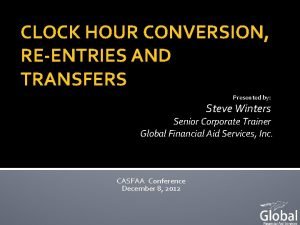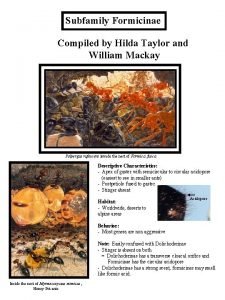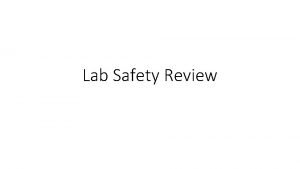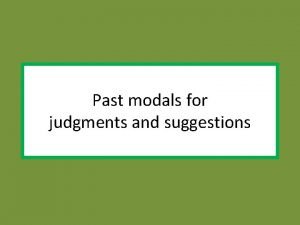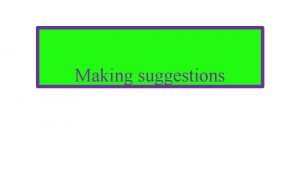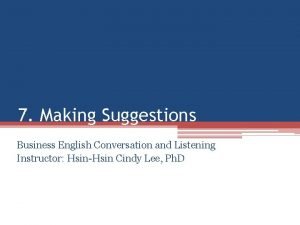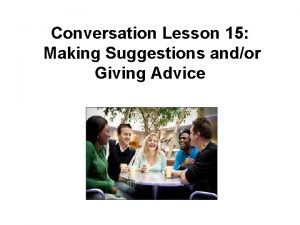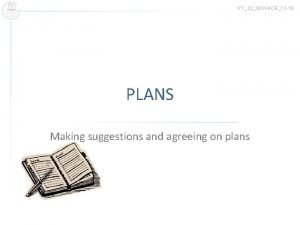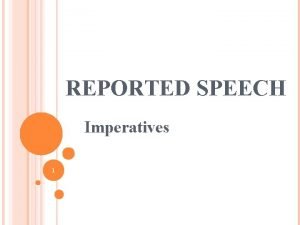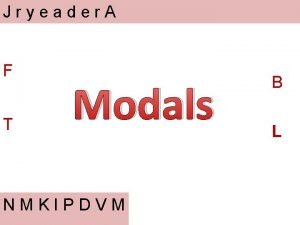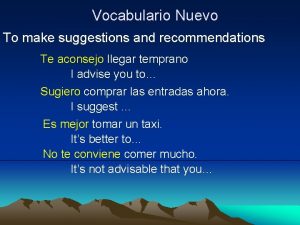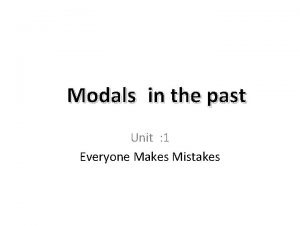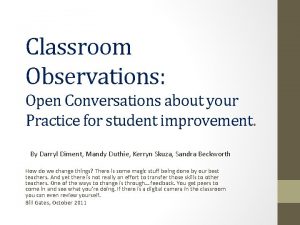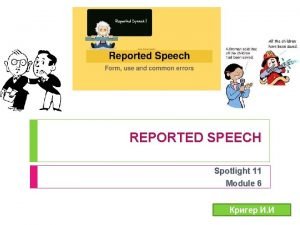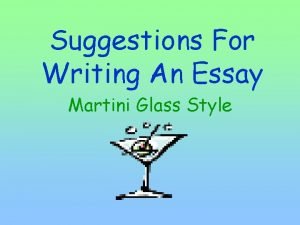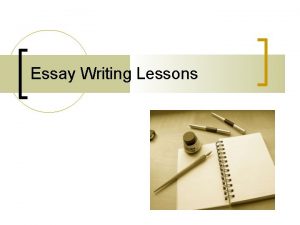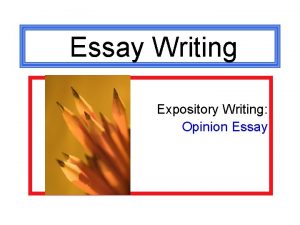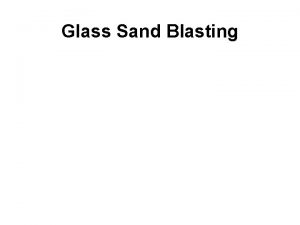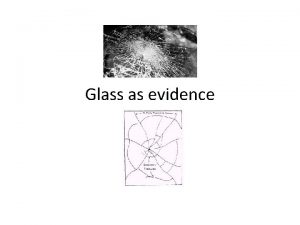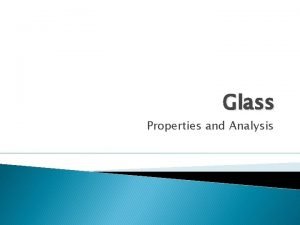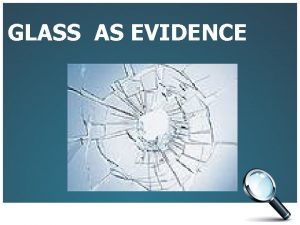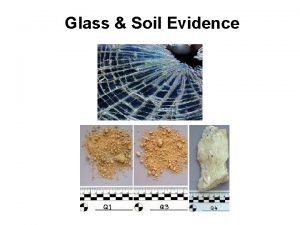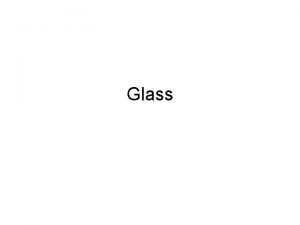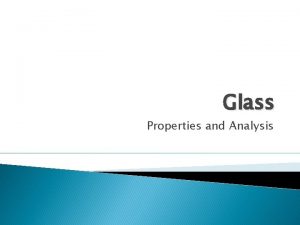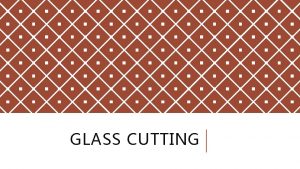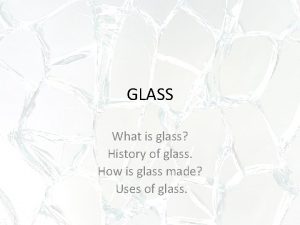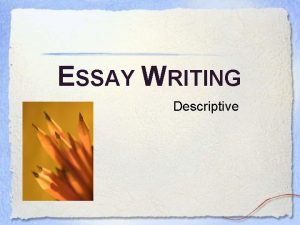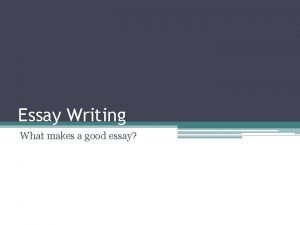Suggestions For Writing An Essay Hour Glass Introduction




















- Slides: 20

Suggestions For Writing An Essay Hour Glass

Introduction Body Paragraphs Conclusion End

Introduction Broad, General Statements Bridge Background 3 -5 sentences Thesis Specific Go to Hour Glass

Body Paragraphs How to write the paragraph Go to Hour Glass

Conclusion Sentences 1, Sentence 2 -3 Go to Martini Glass

Broad, General Statements • Sentences # 1 • Start essay with 1 broad, general statement that is in some way related to thesis of your paper • Relate the essay’s opening statements to real world issues Back to “Introduction”

Bridge • Sentence # 2: • Connect broad, general opening statement to author and Title • Underline Title for novels and plays • Use quotation marks around “Title” of poems, short stories, or essays Back to “Introduction”

Background • Sentences # 3 -4: • Write 1 -2 sentences that provide a concise summary of relevant plot, character and setting details • Create a foundation that introduces characters and events your paper will analyze in detail Back to “Introduction”

Thesis Statement • Sentence # 4 or 5: • An opinion statement linked directly to the book being analyzed that is the central focus of the entire essay. • Thesis = the point that your essay will prove Back to “Introduction”

Topic Sentences • Topic sentence: Phrase as OPINION statements related to your thesis & to the literary work(s) your essay is examining – Link topic sentences DIRECTLY to the book being analyzed (by naming a character or the author) • AVOID phrasing topic sentences as an abstract generalization about “people” or “you. ” Back to “Body Paragraphs”

Pinpoint • Pinpoint: is a set up for a quotation or for a concrete detail – Establish the CONTEXT of the quotation/example that will be used – Provide a mini plot summary: briefly describe the plot events that lead up to the quotation – Identifies who is speaking or thinking or commenting in the forthcoming quotation – 1 -4 sentences in length

Quotes & Concrete Details • Quote/Concrete Detail: Evidence that helps prove your thesis – Make sure it relates to your topic sentence & thesis – Limit yourself to 1 - 2 well chosen quotes maximum per body paragraph

Commentary – 2 -4 sentences minimum – Explain the meaning or significance of the quotation – Connect quotation or specific example back to your thesis – Write about your thesis directly in every body paragraph – Avoid referring to the quote as a “quote; ” better to say: passage, statement, excerpt, or describe the character’s thought, idea or what he/she “expresses” Conclusion

Conclusion Sentences 1, 2, 3, • Emphasize your main points & echo your thesis statement. • Try writing at least one sentence about your body paragraphs • Connect your main points directly to your thesis statement. • Avoid repeating your thesis word for word.

Conclusion Sentences 2 -3 • Make a Leap: Connect thesis back to Larger, Real-Life Issues • Explain how thesis of your essay or a key issue in the story/novel/play your paper is about or relates to real life, to real people, to real issues facing humanity. • Link the story’s themes, conflicts, issues, hardships, and struggles to the real life struggles people face today or have faced throughout time. • Use phrases like “Like (character’s name), we all face…. ” “As (Author’s Last Name’s) story shows, people throughout time have had to face…. ” Go to “Reminders on Conclusions”

Reminders on Conclusions • No QUOTES in a conclusion • Mention the author(s) OR “Title(s)” OR character(s) at least once • No need to repeat ALL authors and titles • Think “BIG PICTURE” or “REAL LIFE” as you end your paper Back to “Conclusion”

Essay Do’s & Don’ts • Avoid all uses of: I, me, my, your • Avoid the following “announcing” phrases: - “this shows” - “in conclusion” • Do NOT use the words: essay, thesis, quote • Be careful using: it, this, that

Your Prompt • Although many people feel like outsiders as young adults because of the imposition of stereotypes, they do not let these stereotypes define them. Write an essay explaining how Namioka’s cultural identity has influenced her life, but did not define her completely. • Be sure to — • clearly state your thesis • organize and develop your ideas effectively • choose your words carefully • edit your writing for grammar, mechanics, and spelling • include anecdotes or quotations from “Math and After Math” in your body paragraph(s) to support your thesis

Deconstruct the Prompt

THE END
 What is the time
What is the time Semester vs trimester
Semester vs trimester Ulcer niche and ulcer notch
Ulcer niche and ulcer notch Hour glass
Hour glass Glass escalator concept
Glass escalator concept If acid is splashed on your skin wash at once with
If acid is splashed on your skin wash at once with Does hot glass look like cold glass
Does hot glass look like cold glass Body paragraph structure
Body paragraph structure Past modals
Past modals Making suggestions expressions
Making suggestions expressions Business meeting conversation
Business meeting conversation Suggestions and advice
Suggestions and advice Making plans and suggestions
Making plans and suggestions Direct speech imperative sentences
Direct speech imperative sentences I wasn't or i didn't
I wasn't or i didn't Making suggestions and recommendations
Making suggestions and recommendations Comments and suggestions for teachers observation
Comments and suggestions for teachers observation Perfect modals examples
Perfect modals examples Comments and suggestions for teachers observation
Comments and suggestions for teachers observation Say and tell differences
Say and tell differences Suggestions and queries
Suggestions and queries

